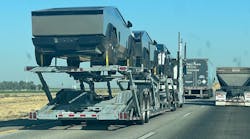It was apparently without irony that the California Highway Patrol Buttonwillow Area’s Facebook page featured several photos of new Tesla Cybertrucks being hauled down I-5 north of Los Angeles, with the majority of social media comments showing much enthusiasm for the new electric pickup truck. Its futuristic design and stainless steel “exoskeleton” garnered an Elon Musk-worthy amount of attention when the prototype was unveiled in late 2019.
But, as with many of us in the trucking world, I imagine, the first thing I looked at in the highway patrol photos was the car-hauler rig—specifically, what tractor was pulling the load? For the record, it was a classic long-hood Pete. Why does that matter?
Well, my grandfather was a small businessman who tried his hand at all sorts of things, and he had a very strict rule for his family: We did not do business with the competition. Buying a cool shirt at another retailer in town wasn’t going to make or break anyone, but it looked bad to be seen shopping elsewhere. Likewise, he’d check out the parking lots of competing motels to count cars—and if you were a cleaning supplies vendor for my grandfather, your drivers better not park their vans at another inn overnight.See also: CEVIC 2023 explores the future of fleet electrification
Now, Elon Musk is nothing if not a world-class self-promoter. Surely someone in the organization suggested Tesla Semis needed to be hauling some of these early Cybertrucks. But if there are photos, even staged, I didn’t readily find them.
The reality, of course, is that while Tesla Semis are finally on the road, there are only certain long-haul lanes where a heavy-duty electric vehicle can recharge. So, for once, I don’t mind giving Mr. Musk and his hype machine the benefit of the doubt. Even as Tesla takes the lead in various charging and storage technologies, Musk can’t control everything. As with other commercial EV manufacturers and fleets, he’s at the mercy of the infrastructure.
(But I will pile on: A TikTok video caught a batch of Cybertrucks, reportedly in Missouri, being hauled by a Ram pickup. Ouch.)
CEV evolution
In the first several years that I was with FleetOwner, I drove various vans and pickups with electric drivetrains at the Work Truck Show and IAA, but the CEV world definitely shifted in November 2017 when Musk, to much fanfare, unveiled the Tesla Semi.
I was in Guadalajara, Mexico, for that year’s Expo Transporte, but a number of trucking industry editors, over dinner, streamed the Tesla event on an iPad. Not unrealistically, we agreed that we’d believe Musk’s hype when we could see it and that the existing heavy-duty OEMs would certainly apply their vast global resources to keep any startup electric truck builder from taking a market lead.
See also: Grid not prepared for electric truck 'avalanche'
And just seven months later, Daimler Truck North America (DTNA) introduced the Freightliner eCascadia heavy-duty truck and Freightliner eM2 medium-duty model. Within two years, Freightliner’s Innovation Fleet —a line of 30 battery-electric medium- and heavy-duty trucks—logged more than 300,000 miles of real-world use and then hit the one million-mile mark just over a year later.
Volvo Trucks North America, meanwhile, deployed its first Class 8 pilot Volvo VNR Electric trucks to fleet operators for the three-year Volvo LIGHTS project in Southern California.
And early last year, FleetOwner visited the Paccar Innovation Center in Silicon Valley to take a spin in Kenworth’s medium-duty cabovers K270E/K370E and the new Class 8 T680E, along with a 680FCEV, a hydrogen fuel cell EV that Kenworth and Toyota developed.
And, despite delays, even Tesla has moved forward, delivering its Semi for use by PepsiCo North America late last year. Likewise, Nikola’s up-and-down road to hydrogen trucks has taken a positive turn with more than 200 sales orders for the Tre FCEV, from at least 18 customers.
So the trucks are here, but fleets need infrastructure.
I guess all this is just my semi-direct route to another reminder about the upcoming Commercial Electric Vehicle Infrastructure Conference, taking place Sept. 12 in Sacramento. The unique goal for CEVIC is to put fleets in the same room with CEV makers, utilities, charging equipment suppliers, regulators, and public service commissioners to make sure the key players understand the diverse and sometimes divergent expectations of what’s required to make the transition work.
Registration information is here, and special registration codes are available for members of the California Trucking Association and the Western States Trucking Association.





